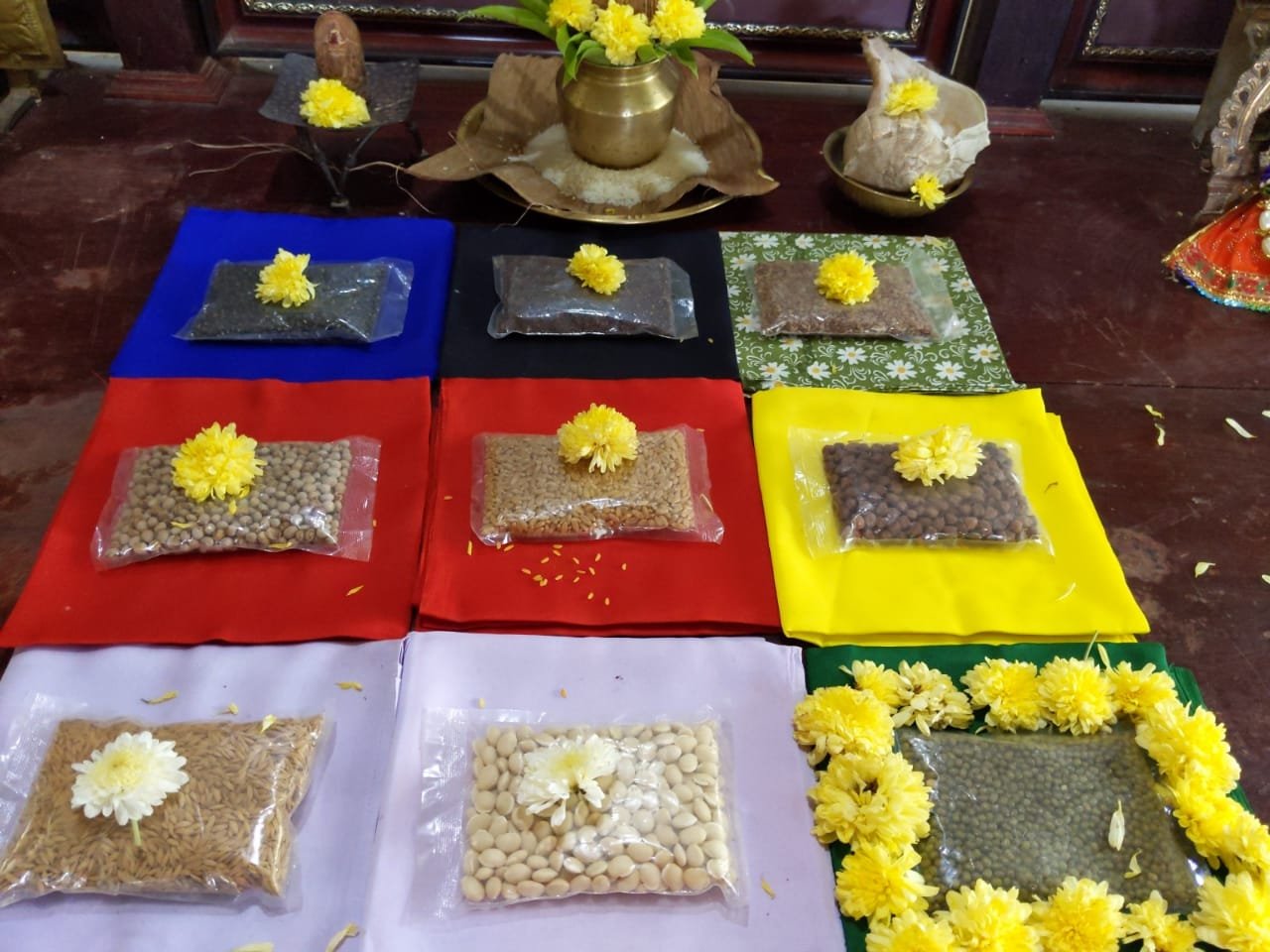 Image 1 of 3
Image 1 of 3

 Image 2 of 3
Image 2 of 3

 Image 3 of 3
Image 3 of 3




Birthday Yagya
A Birthday Yagya offers profound spiritual and material benefits by aligning the individual with the cosmic rhythms present at the time of their birth. Spiritually, it purifies karmic patterns, strengthens the soul’s dharma, and invokes blessings for health, clarity, and inner growth in the coming year. The ritual honors the birth star (janma nakshatra) and planetary influences specific to the individual, offering a unique opportunity to reset one's energetic imprint. Materially, a Birthday Yagya supports longevity, prosperity, harmonious relationships, and success in personal and professional endeavors by reducing the negative effects of planetary afflictions and enhancing beneficial influences. This sacred offering uplifts not only the person for whom it is performed but radiates positivity to their family and community as well.
Elements of the birthday yagya
🔹 1. Ganesha Puja
Purpose: Removes obstacles and ensures the smooth flow of the ceremony.
Deity Invoked: Lord Ganesha
Mantras: Ganapati Atharvashirsha, Ganesha Gayatri
🔹 2. Kalasha Sthapana (Installation of Sacred Pot)
Represents the presence of divine energies.
A copper or silver pot is filled with water, mango leaves, and a coconut placed on top—symbolizing fertility and abundance.
🔹 3. Navagraha Puja and Homa
Purpose: Appease planetary influences that are active in the native’s chart.
Includes individual offerings to the Nine Planets (Navagrahas).
Often customized to the janma nakshatra (birth star) and dasha/bhukti periods active in the person’s life.
Mantras & Offerings: Specific to each planet (e.g., milk for the Moon, sesame oil for Saturn, ghee for Jupiter).
🔹 4. Janma Nakshatra Puja and Homa
Purpose: Strengthen the life force and fulfill the soul’s dharma.
The presiding deity of the person's birth star is honored.
This is considered the most important part of the birthday yagya.
🔹 5. Ayushya Homa (Longevity Fire Ritual)
Purpose: Grants long life, vitality, and health.
Based on the Ayur Veda principle that life span is sacred and can be protected and extended through ritual.
Often includes chanting the Ayushya Sukta from the Rig Veda.
🔹 6. Mrityunjaya Homa (Conquering Death)
Purpose: Removes fear, illness, and untimely death.
Deity Invoked: Lord Shiva as Mrityunjaya (Conqueror of Death)
Mantra: Maha Mrityunjaya Mantra, chanted 108 or 1008 times
🔹 7. Surya Arghya and Surya Namaskar
Offering water to the Sun, the source of prana and consciousness.
Sometimes followed by chanting of the Aditya Hridayam or Gayatri Mantra.
🔹 8. Blessings and Sankalpa Fulfillment
Final prayers are made to seal the sankalpa (intention) of the yagya.
Family, teachers, or priests may give verbal blessings to the birthday person.
Prasad (consecrated offerings) is distributed.
A Birthday Yagya offers profound spiritual and material benefits by aligning the individual with the cosmic rhythms present at the time of their birth. Spiritually, it purifies karmic patterns, strengthens the soul’s dharma, and invokes blessings for health, clarity, and inner growth in the coming year. The ritual honors the birth star (janma nakshatra) and planetary influences specific to the individual, offering a unique opportunity to reset one's energetic imprint. Materially, a Birthday Yagya supports longevity, prosperity, harmonious relationships, and success in personal and professional endeavors by reducing the negative effects of planetary afflictions and enhancing beneficial influences. This sacred offering uplifts not only the person for whom it is performed but radiates positivity to their family and community as well.
Elements of the birthday yagya
🔹 1. Ganesha Puja
Purpose: Removes obstacles and ensures the smooth flow of the ceremony.
Deity Invoked: Lord Ganesha
Mantras: Ganapati Atharvashirsha, Ganesha Gayatri
🔹 2. Kalasha Sthapana (Installation of Sacred Pot)
Represents the presence of divine energies.
A copper or silver pot is filled with water, mango leaves, and a coconut placed on top—symbolizing fertility and abundance.
🔹 3. Navagraha Puja and Homa
Purpose: Appease planetary influences that are active in the native’s chart.
Includes individual offerings to the Nine Planets (Navagrahas).
Often customized to the janma nakshatra (birth star) and dasha/bhukti periods active in the person’s life.
Mantras & Offerings: Specific to each planet (e.g., milk for the Moon, sesame oil for Saturn, ghee for Jupiter).
🔹 4. Janma Nakshatra Puja and Homa
Purpose: Strengthen the life force and fulfill the soul’s dharma.
The presiding deity of the person's birth star is honored.
This is considered the most important part of the birthday yagya.
🔹 5. Ayushya Homa (Longevity Fire Ritual)
Purpose: Grants long life, vitality, and health.
Based on the Ayur Veda principle that life span is sacred and can be protected and extended through ritual.
Often includes chanting the Ayushya Sukta from the Rig Veda.
🔹 6. Mrityunjaya Homa (Conquering Death)
Purpose: Removes fear, illness, and untimely death.
Deity Invoked: Lord Shiva as Mrityunjaya (Conqueror of Death)
Mantra: Maha Mrityunjaya Mantra, chanted 108 or 1008 times
🔹 7. Surya Arghya and Surya Namaskar
Offering water to the Sun, the source of prana and consciousness.
Sometimes followed by chanting of the Aditya Hridayam or Gayatri Mantra.
🔹 8. Blessings and Sankalpa Fulfillment
Final prayers are made to seal the sankalpa (intention) of the yagya.
Family, teachers, or priests may give verbal blessings to the birthday person.
Prasad (consecrated offerings) is distributed.
